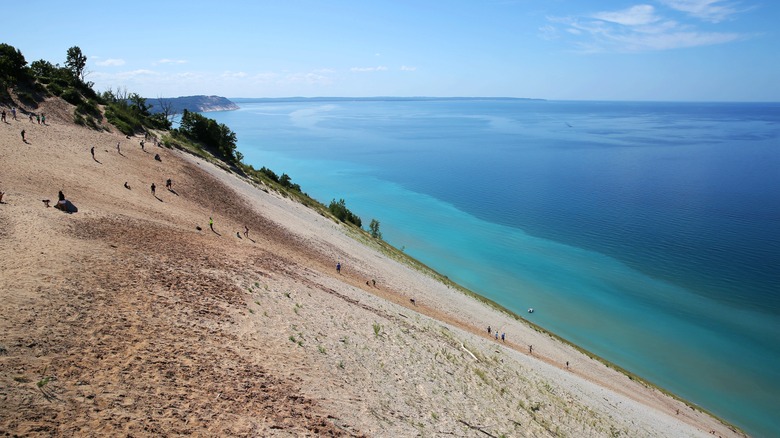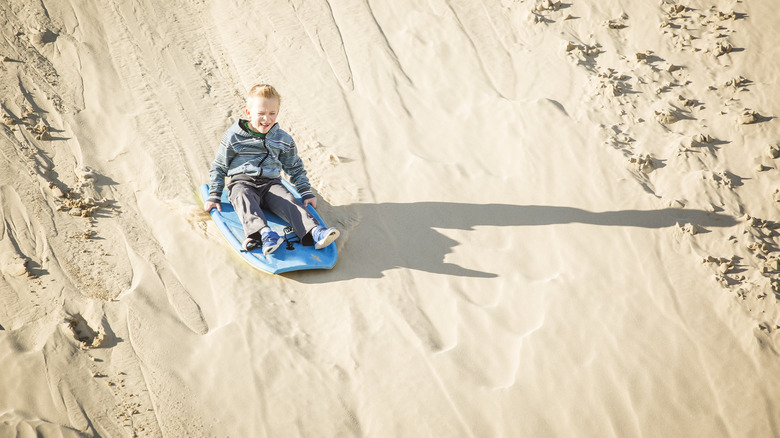You'll Encounter Crystal-Clear Waters At This Underrated Midwest Beach
When you think of taking a dip in azure waters, you probably picture a relaxing vacation in Mexico or the Hawaiian islands. But thanks to the pure water runoff from melted ice, there's a popular destination in Michigan with a similar color palette. The Sleeping Bear Dunes National Lakeshore comprises 71,000 acres of forests, rivers, 450-foot tall sand dunes, 100 miles of marked trails, and 35 miles of soft golden beaches on crystalline water. If you think about how the state is shaped like a left glove, this epic preserve is located on the left side — the pinky — along Lake Michigan. It also includes the North and South Manitou islands just offshore.
Protected by Congress since 1970, Sleeping Bear Dunes holds the most extensive cluster of freshwater sand dunes on Earth and boasts 50 species of mammals and 240 species of birds. The park offers year-round activities for outdoor enthusiasts of all fitness levels. In the fall, it attracts leaf-peepers eager to snap photographs of the fiery leaves along the trails. In the winter, it's ideal for sledding, cross-country skiing, and snowshoeing with a striking backdrop of the blue lake surrounded by bright white powder. By spring, the ice melts to reveal an idyllic landscape dotted in wildflowers. In summer, the weather is perfect for hiking, kayaking, biking, stand-up paddle boarding, camping, and surfing (yes, you can surf on Lake Michigan). No wonder CNN Travel called Sleeping Bear Dunes one of the top places to visit in 2024.
Adventurous things to do at Sleeping Bear Dunes
As any visitor will tell you, the most popular thing to do is hike the Dune Climb, a sandy stretch that towers 284 feet tall above the water. It takes visitors about three hours to complete, but you'll have a gorgeous view of Little Glen Lake to celebrate your win. Though the sand is soft, it can reach 150 degrees Fahrenheit in the middle of summer. The dunes are best reserved for early in the morning or later in the evening with close-toed shoes. If you prefer to visit during winter, you can snowshoe up and sled back down.
For an easier hike, consider Empire Bluff trail, a 1.5-mile trek that snakes through the forest and ends with a vista on a coastal bluff with stunning views of Lake Michigan, North Bar Lake, and the Manitou islands. You can also drive along the 7.4-mile Pierce Stocking Scenic Drive with 12 stops and an observation deck 450 feet up. If you love cycling or roller blading, the Sleeping Bear Heritage Trail has 20 miles of paved trails.
The Crystal River is another popular stop for Midwest kayaking adventures, tubing, and spotting wildlife like deer, beavers, otters, foxes, herons, and bald eagles. Of course, you can always just kick back, sunbathe, and picnic on the shores of Lake Michigan or go sand sledding on the dunefield. To round out your trip, consider a helicopter tour with My Flight Tours ($400) for a view from 2,000 feet up you won't soon forget.
Admission, accommodations, and star parties
Sleeping Bear Dunes is open 24 hours a day. The entrance fee costs between $15 to $25, depending on whether you arrive on foot or in a vehicle. With the wealth of activities, it's best to plan for a few days in the park. There are six campgrounds to choose from, including DH Day Campground right next to the Dune Climb ($20). The Platte River campground offers both tent sites ($22) and RV spots with hookups ($31) all year round. As a bonus, campfires and leashed dogs are welcome. The park is busiest in the summer. To avoid crowds and spot wildlife, consider the shoulder seasons of spring and autumn.
When the sun goes down over one of the iconic west-facing beaches, there's another surprise in store. From May through October, the park rangers work in tandem with the Grand Traverse Astronomical Society (GTAS) to bring monthly star parties for visitors. You might catch an eclipse, meteor shower, or stargaze the constellations with telescopes. Even better, it's all included with your park entrance pass. If you miss one of the star parties, plan your trip around a new moon (when the sky is the darkest) for the best view of the heavens. With so much to do, it's no wonder that more than one million people are drawn to this park every year.


